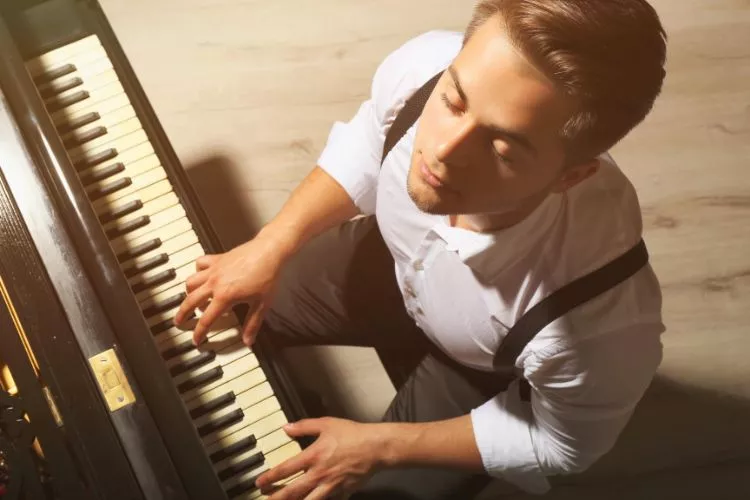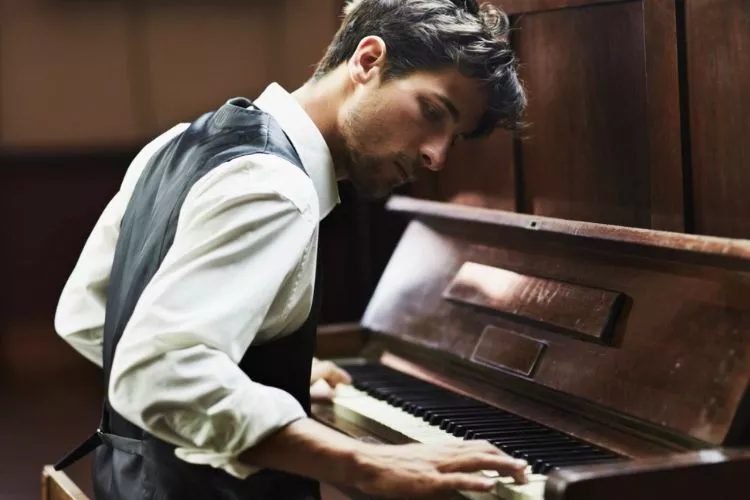The world of piano playing is a captivating one, filled with the harmonious sounds produced by the skilled hands of pianists.
However, if you ever had the opportunity to watch a pianist perform, you might have noticed something intriguing – the pianist’s head moving in sync with the music.
This phenomenon raises several questions: why do pianists move their head while playing? Is it just for showmanship, or does it serve a purpose?

In this article, we will dive deep into the reasons behind pianists’ head movement, exploring its connection to expression, tempo, performance enhancement, and more.
Contents
🎶 Why Do Pianists Move Their Head? Historical Perspectives
Head movement while playing the piano is not a recent trend; it has been observed throughout history. In fact, renowned pianists from different eras have been known for their distinctive head movements.
Take, for example, the legendary pianist Arthur Rubinstein, whose head would gently sway as he played. This movement was not a mere coincidence; it was a manifestation of Rubinstein’s passion and connection to the music he performed.
Similarly, other pianists such as Vladimir Horowitz, Martha Argerich, and Lang Lang have been recognized for their unique head movements that add an extra layer of expression to their performances.
The Role of Expression and Interpretation
One of the primary reasons pianists move their head while playing is to convey emotions and enhance musical expression. The head movements can serve as an extension of the physicality of the music, illuminating the dynamics, phrasing, and nuances.
As pianists immerse themselves in the music, their head movements become a language of expression, allowing them to communicate the depth and intensity of the music to the audience.
Tempo, Rhythm, and Coordination
Head movement also plays a role in maintaining tempo, rhythm, and coordination while playing the piano. The swaying or bobbing motion of the head can help pianists internalize the pulse of the music, ensuring that they stay on beat.

It acts as a metronomic guide, synchronizing the hands with the tempo of the piece. Additionally, the coordination between head movement and the movement of hands comes naturally to many pianists.
The head’s movement can assist in coordinating complex passages, especially when different hands play contrasting rhythms or when intricate fingerings are involved.
Efficiency and Performance Enhancement
Beyond expression and coordination, head movement can contribute to better accuracy, technique, and overall performance enhancement. Some pianists find that certain head movements help them achieve greater focus and concentration.
By engaging the body in this way, pianists can harness additional energy and direct it towards their playing. Studies have shown that physical movements can activate various sensorimotor pathways, improving motor skills and muscle memory.
Therefore, the head movements of pianists can assist in refining muscle coordination and facilitating smoother execution of the music.
The Psychology behind Head Movement in Pianists
To understand why pianists move their head while playing, it is essential to explore the psychological factors behind this phenomenon.

Cognitive scientists suggest that body movements, including head movement, are closely linked to cognitive processing. When a pianist engages in expressive head movement, it can trigger an enhanced mental state, enabling them to delve deeper into the emotional landscape of the music.
The movement not only helps the pianist connect with the piece on a sensory level but also facilitates a profound level of musical interpretation.
The Controversy and Criticism
While many appreciate and admire head movements in pianists, the practice is not without its fair share of criticism and misconceptions.
One common misconception is that excessive head movement is merely for showmanship and can be distracting to the audience.
However, it is essential to differentiate between purposeful, expressive head movement and excessive, unnecessary gestures.
Pianists who exhibit excessive head movements without a genuine connection to the music risk compromising their technical precision and musical integrity.
Therefore, it is crucial for pianists to find the right balance between artistic expression and technical accuracy.
Practical Advice for Pianists
For pianists looking to incorporate head movement effectively into their performances, here are some practical tips and techniques:
- Understand the music: Connect with the piece emotionally and mentally before introducing any physical movements.
- Experiment with different movements: Find natural and organic head movements that complement the mood and character of the music you are playing.
- Balance with technical precision: Ensure that head movement does not hamper your technical accuracy and overall control of the instrument.
- Practice with a mirror: Use a mirror during rehearsals to observe and refine your head movements. This can help you identify excessive or distracting gestures that need to be minimized.
- Seek guidance from a teacher: A skilled piano instructor can provide valuable insights and suggestions on incorporating head movement effectively into your performance.
If you are a beginner: How to Improve Finger Agility for Piano Playing? | How to Practice Sight Reading for Piano?
Conclusion:
The captivating head movements of pianists while playing the piano have a purpose beyond mere theatrics. Head movement serves as a conduit for expression, enhancing emotions and interpretations.
It aids in maintaining tempo, rhythm, and coordination, while also contributing to better efficiency and performance. Understanding the psychology behind head movement reveals the deep connection between body movements and cognitive processing in piano playing.
As with any artistic practice, finding the right balance between expressive freedom and technical precision is crucial. So, the next time you witness a pianist swaying their head in concert, appreciate the intricate connection between their body and the music they create.
